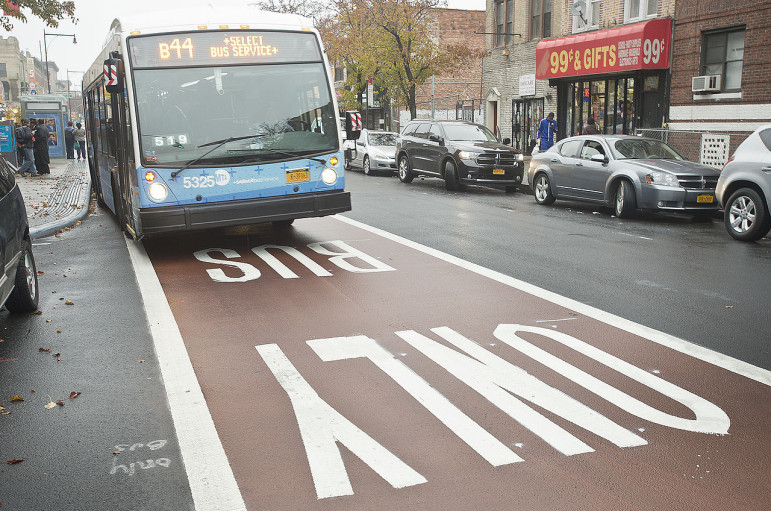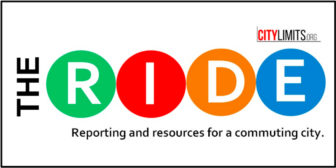
MTA
New Yorkers can fight climate change one bus ride at a time. And that will be easier if a bill is passed to create a citywide bus rapid transit network.
The Department of Transportation is considering a proposal to let Access-a-Ride (AAR) vehicles utilize the city’s bus lanes — an effort to speed up trips for users of the MTA program for disabled commuters, which has been plagued by complaints of slow and inefficient service.
Advocates have been urging the city for the last few years to allow AAR cars into bus lanes, saying the change would help provide faster trips for customers, many of whom rely on AAR because of disabilities that prevent them from taking other public transit options. Trips through the service are often painstakingly slow, users say — rides are shared, so drivers frequently take circuitous routes to pick up other customers, making riders late for work and other engagements.
“It is a huge mess, so we are looking to improve that huge mess in any which way we can,” says Ruth Lowenkron, director of the Disability Justice Program at New York Lawyers for the Public Interest. “People with disabilities who use Access-a-Ride are having the slowest transportation in the city, so if anyone needs access to speed, it is that group.”
The change to the city’s rules, if approved, would allow for wheelchair-accessible AAR vehicles that can seat four or more to use bus lanes on city streets, according the proposal. This would apply to AAR vans, of which there were 1,300 in the program’s fleet as of 2012.
There are approximately 120 miles of bus lanes in the city, according to the transit news site Streetsblog. The city’s Select Bus Service routes, which use such dedicated bus lanes, have proven to travel slightly faster than local bus routes, a report from the Comptroller’s office last year found.
Currently, a eight- to 10-mile trip through AAR takes an average of 55 minutes to complete, according to the program’s latest performance data.
“I can tell you from my own experience that I’ve been stuck in traffic on Access-a-Ride many times, frustrated,” says Valerie Joseph, an AAR user and organizer with the Brooklyn Center for Independence of the Disabled who testified during a DOT hearing about the proposal Thursday, pointing out that existing rules let tour and charter buses use the city’s bus lanes. “Why not us?”
DOT officials said the agency will take the public’s comments into consideration before deciding whether to adopt the change. But advocates are pushing the agency to broaden the proposal to allow not just larger AAR vans but also the program’s smaller sedans to utilize bus lanes.
Advocates say the rules should also allow broker AAR vehicles — taxis or for-hire cars like Uber or Lyft—to use the bus lanes if they’re transporting AAR customers. Last month, the MTA announced it was shifting more of its AAR rides to taxis and FHVs, which cost less than trips in standard AAR-branded cars.
“You need to allow all AAR vehicles, including those which are considered broker vehicles, because that is the way of the future — that is the way the MTA is moving,” says Lowenkron.
Accessibility advocates are also pushing for other improvements, including calling for the MTA to expand and make permanent a pilot program that allows AAR riders to book their rides on demand, as opposed to a day or two in advance as the standard service currently requires.
Improving the program is a matter of equity, advocates say, pointing to the inaccessibility of the city’s subway system as the reason many of those with disabilities must use AAR instead.
“I hear everyday from users about missed appointments, stressful experiences and frustration from having to rely on Access-a-Ride, an unreliable service fundamentally unequal to transportation options New Yorkers who use the subways and buses take for granted,” Shain Anderson, an organizer with the Center for the Independence of the Disabled, New York, told DOT officials Thursday.











5 thoughts on “City Considers Letting Access-a-Ride Vans Use Bus Lanes to Speed Up Trips for Riders with Disabilities”
Pingback: CityLimits Quotes NYLPI in Access-A-Ride Bus Lane Story - New York Lawyers for the Public Interest
As a rider who uses the broker vehicles almost exclusively (I ride with a walker and don’t need the lift to enter a sedan or SUV) I don’t see the need to broaden the proposal to allow broker vehicles to use the bus lanes. Customers who use the AAR busses should be given every chance to get this passed as they are the ones most disadvantaged by the slowness of the AAR system. Broker vehicles are faster and smaller and have lots of advantages already, and adding them to this proposal only impedes progress for the people who really need it- wheelchair bound and otherwise mobility impaired customers who need the hydraulic lift.
Additionally, it’s harder to enforce compliance for broker vehicles, which look like regular livery cars (because they are). It’s easier for enforcement to that the AAR busses belong there.
Allow AAR busses to use the bus lanes first, and see how it goes. Just my two cents.
Well they already let them drive like maniacs so I don’t see what the harm there will be of having them drive like maniacs in the bus lane.
Pleeeease…Access-a-Ride???? That is the ‘worst nightmare’ you could go thru… The most ‘inefficient service possible’ in a city, that is Access’. =always-always-always= late to begin with. Then they are now using car-service vehicles/drivers. Always late= @ one time. I was @ 190 St in Washington Heights, awaiting a car to go home in Inwood. Well, the car that showed up, instead of taking me from 191st in Wash, Heights………………he went to pick up a passenger in 125st Stree in Harlem instead of taking me home first!!!!!
Pingback: Brooklyn Lawmakers On The Move May 3, 2019